A level biology
A-level BIOLOGY
Seite 4 aus 279 Ergebnisse
Sortieren nach
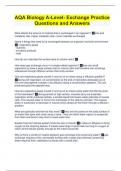
-
AQA Biology A-Level- Exchange Practice Questions and Answers
- Prüfung • 3 Seiten • 2024
-
Im Paket-Deal erhältlich
-
- 7,64 €
- + erfahre mehr
What affects the amount of material that is exchanged in an organism? size and metabolic rate- higher metabolic rate= more materials exchanged Name 4 things that need to be exchanged between an organism and their environment. - respiratory gases - nutrients - excretory products - heat How do you calculate the surface area to volume ratio? How does gas exchange occur in a single-celled organism? they are small organisms so have a large surface area to volume ratio and therefore can e...

-
A level Biology Practical Exam Questions and Answers
- Prüfung • 6 Seiten • 2024
-
Im Paket-Deal erhältlich
-
- 7,64 €
- + erfahre mehr
Explain why the data in the table above are described as processed results. (1) Calculations made from the raw data Describe how you would use a 1.0 mol dm−3 solution of sucrose to produce 30 cm3 of a 0.15 mol dm−3 solution of sucrose (2) *Use ratios 0.15 : 0.85 Add 4.5 cm3 of (1.0 mol dm-3) solution to 25.5 cm3 (distilled) water Describe how you would use the student's results in the table above to find the water potential of the potato tissue. (3) 1. Plot a graph with concentra...
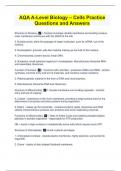
-
AQA A-Level Biology – Cells Practice Questions and Answers
- Prüfung • 23 Seiten • 2024
-
Im Paket-Deal erhältlich
-
- 11,94 €
- + erfahre mehr
Structure of Nucleus. 1. Nuclear envelope: double membrane surrounding nucleus, outer membrane continuous with the (R)ER of the cell. 2. Nuclear pores: allow the passage of larger molecules, such as mRNA, out of the nucleus. 3. Nucleoplasm: granular, jelly-like material making up the bulk of the nucleus. 4. Chromosomes: protein-bound, linear DNA. 5. Nucleolus: small spherical region(s) in nucleoplasm. Manufactures ribosomal RNA and assembles ribosomes. Function of Nucleus. 1. Controls...
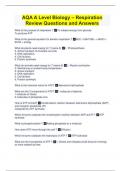
-
AQA A Level Biology – Respiration Review Questions and Answers
- Prüfung • 4 Seiten • 2024
-
Im Paket-Deal erhältlich
-
- 7,64 €
- + erfahre mehr
What is the purpose of respiration ? To release energy from glucose To produce ATP What is the general equation for aerobic respiration ? 6O2 + C6H1206 --> 6H2O + 6CO2 + energy What do plants need energy for ? (name 5) 1. Photosynthesis 2. Active transport of minerals via roots 3. DNA replication, 4. Cell division, 5. Protein synthesis What do animals need energy for ? (name 6) 1. Muscle contraction 2. Maintaining a constant body temperature 3. Active transport 4. DNA replicati...
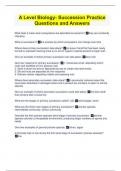
-
A Level Biology- Succession Practice Questions and Answers
- Prüfung • 3 Seiten • 2024
-
Im Paket-Deal erhältlich
-
- 7,64 €
- + erfahre mehr
What does it mean when ecosystems are described as dynamic? they are constantly changing What is succession? the process by which ecosystems can change over time Where does primary succession take place? an area of land that has been newly formed or exposed meaning there is no soil or organic material present to begin with Give an example of where primary succession can take place: bare rock Give four reasons for primary succession: 1. Volcanoes erupt, depositing which cools and solidi...

Angst, etwas zu verpassen? Dann tu es nicht!


-
A-Level Biology – OCR Test Questions with Detailed Answers
- Prüfung • 22 Seiten • 2024
-
Im Paket-Deal erhältlich
-
- 10,99 €
- + erfahre mehr
What is a light microscope used for? Observing living and dead specimens What are the pros and cons of a light microscope? Pros: Cheap, portable, easy to use, can study living specimens. Cons: Limited magnification, poor resolution. What is a laser scanning confocal microscope used for? Creating a high resolution, high contrast image, at different depths of the specimen. What is a transmission electron microscope be used for? Observing the internal ultrastructure of cells under high mag...
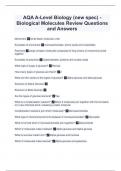
-
AQA A-Level Biology (new spec) - Biological Molecules Review Questions and Answers
- Prüfung • 6 Seiten • 2024
-
Im Paket-Deal erhältlich
-
- 7,64 €
- + erfahre mehr
Monomers Small basic molecular units Examples of monomers monosaccharides, amino acids and nucleotides Polymers Large complex molecules composed of long chains of monomers joined together Examples of polymers Carbohydrates, proteins and nucleic acids What type of sugar is glucose? Hexose How many types of glucose are there? 2 What are the names of the types of glucose? Alpha-glucose and beta-glucose
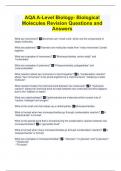
-
AQA A-Level Biology- Biological Molecules Revision Questions and Answers
- Prüfung • 11 Seiten • 2024
-
Im Paket-Deal erhältlich
-
- 8,12 €
- + erfahre mehr
What are monomers? Monomers are *small units* which are the components of larger molecules. What are polymers? Polymers are molecules made from *many monomers* joined together. What are examples of monomers? *Monosaccharides, amino acids* and *nucleotides* What are examples of polymers? *Polysaccharides, polypeptides* and *polynucleotides* What reaction allows two monomers to bond together? A *condensation reaction* allows *two monomers* to be joined together by a chemical bond, *r...
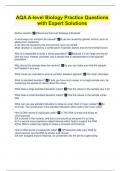
-
AQA A-level Biology Practice Questions with Expert Solutions
- Prüfung • 15 Seiten • 2024
-
Im Paket-Deal erhältlich
-
- 8,60 €
- + erfahre mehr
Define variation Differences that exist between individuals In what ways can variation be caused? It can be caused by genetic factors, such as alleles from mutations. It can also be caused by the environment, such as climate. Most variation is caused by a combination of genetic factors and environmental factors Why is it impossible to study a whole population? Because it is too large and would take too long. Instead, scientists use a sample that is representative of the species' popul...
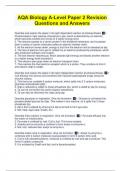
-
AQA Biology A-Level Paper 2 Revision Questions and Answers
- Prüfung • 14 Seiten • 2024
-
Im Paket-Deal erhältlich
-
- 8,60 €
- + erfahre mehr
Describe and explain the steps in the light dependent reaction of photosynthesis 1. Photoionisation: light reaches chlorophyll in psii, which is absorbed by an electron, which becomes excited and moves to a higher energy level. 2. The electron passes to a carrier protein in the thylakoid membrane, and is passed down a series of carrier molecules called an electron transfer chain. 3. As the electron moves down, energy is lost from the electron and is released as atp. 4. The loss of elect...

Fragst du dich auch, warum so viele deiner Kommilitonen coole Klamotten tragen, zum Ende des Monats noch Geld zur Verfügung haben und gleichzeitig ihre Freizeit genießen? Nun, sie verkaufen auf Stuvia! Stell dir vor, deine Studienunterlagen werden ein Dutzend Mal für je 15 € heruntergeladen. Jeden. Einzelnen. Tag. Entdecke alles über Verdienstmöglichkeiten auf Stuvia
